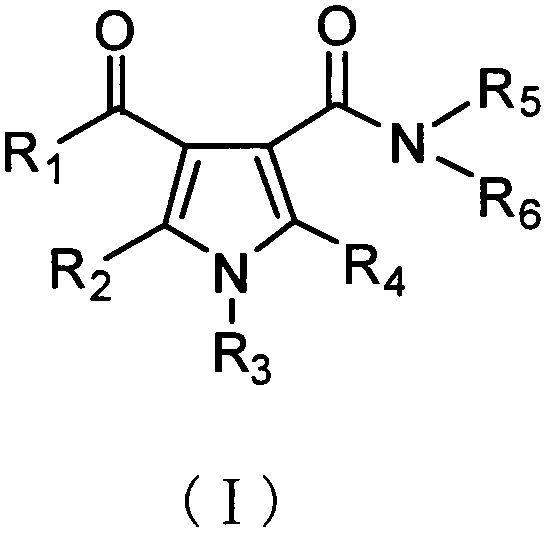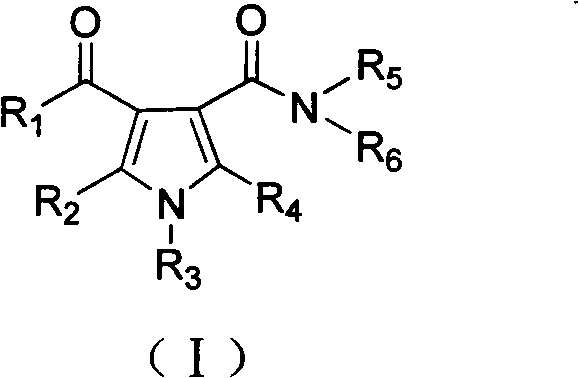Pyrrole formamide derivative, and preparation method and application thereof
A technology of formamide and pyrrole, which is applied in the field of compounds with anti-tumor effects and their preparation, and can solve problems such as damage, mutagenesis, toxic and side effects, etc.
- Summary
- Abstract
- Description
- Claims
- Application Information
AI Technical Summary
Problems solved by technology
Method used
Image
Examples
Embodiment 1
[0057] Example 1: Intermediate III-1
[0058]
[0059] Add 22.1g (0.1mol) 4-acetyl-1-cyclopropane-2,5-dimethyl-1H-pyrrole-3-carboxylic acid into the reaction flask equipped with stirring, condenser and thermometer, and use 200ml di It was dissolved in thionyl chloride, stirred, and refluxed for 4h (the plate showed that the reaction was complete). Thionyl chloride was evaporated to dryness to obtain a white solid (HPLC: 99.7%). HRMS(m / z)[M+H] + : 241.0684.
Embodiment 2
[0060] Example 2: 4-acetyl-N, N-bis(2-chloroethyl)-1-cyclopropyl-2,5-dimethyl-1H-pyrrole-3-amide (compound I-1)
[0061]
[0062] Add 23.9g (0.1mol) intermediate III-1, 21.4g (0.12mol) bis(2-chloroethyl)ammonia hydrochloride, 20.2g triethylamine in the reaction flask equipped with stirring, thermometer and condenser and 200ml of DMF, stirred, refluxed for 5h, TLC showed that the reaction was complete, washed with saturated brine (50ml×3), dried the dichloromethane layer with anhydrous sodium sulfate, filtered, and evaporated the solvent under reduced pressure to obtain a light yellow solid. Column separation [mobile phase: v (petroleum ether): v (ethyl acetate) = 1: 1] to obtain a white solid (HPLC: 99.5%). HRMS(m / z)[M+H] + : 293.1279.
[0063] Referring to the method of Example 1, compounds I-2 to I-5 can be synthesized.
[0064]
Embodiment 3
[0065] Example 3: 4-acetyl-1-cyclopropyl-N, N-bis(2-nitrate ethyl)-2,5-dimethyl-1H-pyrrole-3-carboxamide (compound I- 6)
[0066]
[0067] Add compound I-1 (2.9g, 0.01mol) in the reaction flask equipped with stirring, condenser, thermometer, anhydrous acetonitrile (30ml) dissolves, add the anhydrous acetonitrile solution of silver nitrate (2.0g, 0.012mol) ( 10ml), and refluxed for 5 hours under stirring in the dark. TLC showed that the reaction was complete, then cooled to room temperature, and evaporated the solvent under reduced pressure. Dichloromethane (20ml) was added to the residue, stirred for 10min, filtered, and the filtrate was evaporated to dryness under reduced pressure. Add absolute ethanol (30ml), decolorize with activated carbon, evaporate to dryness under reduced pressure, and dry under reduced pressure at room temperature overnight to obtain yellow transparent oil I-6 (3.6g, yield 90%), purity 99.2% (HPLC method). HRMS(m / z)[M+H] + : 339.1471.
PUM
 Login to View More
Login to View More Abstract
Description
Claims
Application Information
 Login to View More
Login to View More - R&D
- Intellectual Property
- Life Sciences
- Materials
- Tech Scout
- Unparalleled Data Quality
- Higher Quality Content
- 60% Fewer Hallucinations
Browse by: Latest US Patents, China's latest patents, Technical Efficacy Thesaurus, Application Domain, Technology Topic, Popular Technical Reports.
© 2025 PatSnap. All rights reserved.Legal|Privacy policy|Modern Slavery Act Transparency Statement|Sitemap|About US| Contact US: help@patsnap.com



